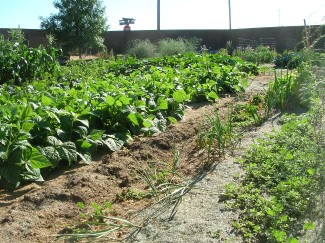
(**CAF Note: This letter comes from a great Montana ally who understands the importance and power of soil. For those of you who have not focused on the opportunity to improve soil and nutrition, it is a good introduction and includes a variety of sources to get you going. For those of us who are starting this Spring planting, consider having your soil tested and taking steps to build your soil.**)
Dear Catherine,
I hope this note finds you thriving in Tennessee this late winter as we near the upcoming equinox. I first wish to recognize your efforts in producing the superbly educational Solari Report which is both respected and appreciated weekly by our family amongst others. The topics presented for discussion are regularly intriguing and highly informative; ensuring as a subscriber that I’m challenged while reinforcing my beliefs as each of us forecasts the road ahead on the horizon.
I have worked with a small family garden for the past 7 years that has each year produced what I would term an incrementally increasingly flavorful and productive garden. More recently, I have seen success in providing produce through a limited CSA experiment of sorts with close friends. The demand has been overwhelming for what is produced on this plot; which I attribute to both taste and a belief by others in me and the soil amendments I’ve chosen each season. This in turn has energized me further to explore how we may ensure that foods not only taste better and fresher but also provide the most nutrition possible. I have recently spent time focusing further on soil science as it relates to providing food of a high nutritional quality. In my studies, I have observed that soils in general produce highly variable nutrient quality dependent upon a range of factors relating specifically to soil composition, element availability and storage capacity of the soil. In light of your gracious efforts to educate the subscribers of the Solari Report on topics ranging from health and well being to food, I wish to introduce this topic of discussion to you if you’re yet unfamiliar with it.
The term best describing the goal of these efforts of soil amending is a quest for nutrient dense food. The depletion of soil nutrients and minerals in soils throughout this country continues at a furious pace as big agricultural entities focus on the bottom line financials and other shadowy ideals. As economic times become tougher, the small family farms may especially focus on ensuring the largest bushel production from the land they farm to turn the largest profit possible, if only to pay down outstanding credit. A larger yield with cheaper fertilizer input ensures “success” from the standpoint of many; but at what cost? While pesticide and GMO considerations in our food supply are of immense importance, I believe there remains a less explored, yet equally important concern relating to the nutrient density of individual food products.
I liken the soils that produce the food bounty we require as a storage pantry full of a diverse range of the various elements. As crops are produced, many elements are removed to varying degrees as crops are taken to market and consumed elsewhere. As time passes and the soil not fully replenished, crops may incrementally require more fertilizer applications and may also face further disease pressures as this reservoir of elements is depleted. The cost of fertilizer application increases with increasing application frequency and therefore cheaper fertilizer options are sought. For example, potassium chloride (KCl) is a common amendment that is also relatively cheap and often chosen for use on large scale farms. In use, this comparatively harsh Potassium fertilizer destroys much organic matter and reduces the exchange capacity of the soil while requiring increasing usage of the product as the soil is aged and the holding capacity reduced.
March 18, 2014There exists a body of research dating back more than 60 years that has been all but buried by various agriculture entities that shows balancing soil nutrients can ensure uptake by plants of all the necessary elements required in the human diet at much greater levels than we can expect in most grocery store or farmers market produce today. In fact, observing that a serving of Broccoli purchased amongst any common market can be expected to have a known and specific amount of sugars, fiber, protein and various vitamins requires a search for further information. Specifically, one would need to test the vegetable sample for the nutrient qualities in a lab setting. More generally, one must know who grew the produce, where it was grown and obtain data on the soil it was grown in ensuring the proper balance of nutrients with the soil to provide for the most nutrient dense vegetable possible. Adding organic products to the soil such as incomplete compost and basic NPK (Nitrogen – Phosphate – Potash) fertilizers is generally not enough if our goal is to provide the most nutrition possible per serving of food stuffs. If growing in a balanced soil, it becomes possible to achieve nutrient dense food regularly with better tasting produce.
Historical data suggest that nutrient density varies greatly within the Continental US and increases from South to North and From East to West attributable directly to the quality of soils. While this remains a generalization, it opens the door to an idea that individual soils regularly produce varying levels of nutritional quality of foods. There remains a separate issue entirely related to whether a product is organic or non?organic which lends itself to an observation of pesticide application in this county. Even the small plot of land that produces our family vegetables enjoys soil that varies greatly from that even 100 feet away due in no small part to the supplemental fertilization program and planning to achieve a balanced soil capable of growing the highest nutrient quality produce.
It is my belief that much of the health issues facing people in the United States and elsewhere can be solved through diet and nutrition. The nutrient quality of fresh produce and often local foods has suffered a decline for several decades according to the data available. While not a unique or new idea, much study and methodology has been presented for many decades on this matter. I believe many agricultural practices overlook the identification and quantification of the nutrient dense qualities of food. While in some cases we may measure the protein content of wheat for example, we generally do not measure an equivalent value present in fruits or vegetables let alone the full range of nutrients other than a common Brix (sugar) content where desired. Food is very often sold by the pound and as a farmer I may broadcast a fertilizer on my crop that ensures the production of large numbers of carbohydrate sugars at the expense of protein or other essential vitamin production within the plant. Herein lays one of the more curious phenomenons that remain; readily correctable through the application of science and the education of the populace.
The human body has a great need for a highly variable amount of many elements, some in large quantities and others on the order of parts per million (ppm). If a particular diet consists of food from one single location, with a soil proven lacking in one or more elements, the plant cannot uptake a particular element and as such human diets suffer from a lack of this specific nutrient. In many cases, the balancing of various cations such as Calcium (Ca) and Magnesium (Mg) or trace elements such as Zinc (Zn) or Copper (Cu) can positively affect the nutrient uptake of the many other various elements. Further, a soil may have abundance of a specific element but for various reasons it may be unavailable due to a multitude of factors.
The primary apparatus by which I can begin to transform a soil begins with a soil sample sent to a lab for composition analysis. My goal through soil testing is to evaluate a soil and determine where the deficiencies may be found. However, the bigger picture differs from what we’re accustomed to when prescribing soil fertilizers. Ultimately, I believe the goal is to stock the soil pantry full of elements in the correct balance and in quantities that make each element available to the plant by ensuring a large reserve of each. To achieve this balance requires variations between each soil type but may relate amongst others to increasing organic matter, building humus in the soil, increasing the cation exchange capacity (CEC) of the soil and providing the necessary trace nutrients even in ppm quantities.
It stands to reason there is more than just one single recipe for a properly balanced soil based on a broad classification of soil types known. The “nutrient dense” target soil composition varies significantly from the typical recommendations found by soil analysts across the country but is one well worth discussing. The trend toward less nutrition in each of our fresh foods can be reversed and improved with some simple efforts. Imagine, if you will, consuming one half the serving as usual of fresh vegetables while obtaining twice the nutrition with that same amount! After all, what is more important than ensuring a quality diet to help empower ourselves to face the great challenges of these generations.
I’ve attempted provide a broad overview of nutrient dense food for your consideration as a possible topic on the Solari Report. While I recognize the soil science specifics may be overwhelming for many, the topic remains important and beneficial to a wide target audience. These ideas specifically have resonated on a local level with those I’ve conversed with and I imagine it would be of interest to your audience on a national scale. There are many resources available to discuss these topics and if you’re interested I can provide some ideas for further direction. One pioneer of the field includes the late William Albrecht whose studies have been of great value to this agricultural community. The science is widely available to support these conclusions and while seemingly ignored for decades, I believe this is one of the greatest food topics that have been overlooked to date. Our health remains dependent upon the nutrient composition of the food products we eat and the high variability within otherwise identical crops requires us to secure a reliably nutritious source of fresh food.
Sincerely, Connery Wiggin

Related Reading:
Steve Solomon With Erica Reinheimer – The Intelligent Gardener
William Albrecht Papers – Reprinted Works Published By Acres USA
The Ideal Soil – Michael Astera
Online OrganiCalc Soil Amendment Tool By Erica Reinheimer
Black Lake Organics – Source Of Organic Fertilizer Mixes & Soil
Amendments
